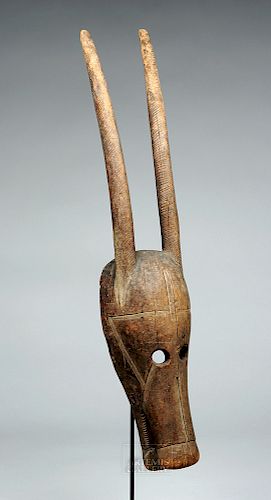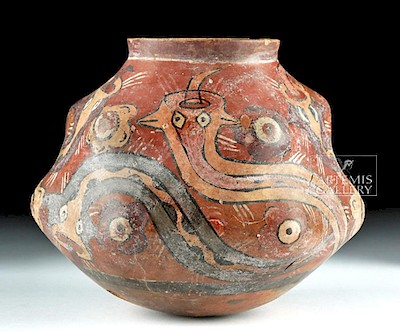20th C. Mali Bamana Wood Antelope Mask
Lot 182
About Seller
Artemis Gallery
686 S Taylor Ave, Ste 106
Louisville, CO 80027
United States
Selling antiquities, ancient and ethnographic art online since 1993, Artemis Gallery specializes in Classical Antiquities (Egyptian, Greek, Roman, Near Eastern), Asian, Pre-Columbian, African / Tribal / Oceanographic art. Our extensive inventory includes pottery, stone, metal, wood, glass and textil...Read more
Categories
Estimate:
$2,300 - $3,450
Absentee vs Live bid
Two ways to bid:
- Leave a max absentee bid and the platform will bid on your behalf up to your maximum bid during the live auction.
- Bid live during the auction and your bids will be submitted real-time to the auctioneer.
Bid Increments
| Price | Bid Increment |
|---|---|
| $0 | $25 |
| $300 | $50 |
| $1,000 | $100 |
| $2,000 | $250 |
| $5,000 | $500 |
| $10,000 | $1,000 |
| $20,000 | $2,500 |
| $50,000 | $5,000 |
| $100,000 | $10,000 |
| $200,000 | $20,000 |
About Auction
By Artemis Gallery
Jul 5, 2018
Set Reminder
2018-07-05 10:00:00
2018-07-05 10:00:00
America/New_York
Bidsquare
Bidsquare : Ancient | Ethnographic | Fine Art
https://www.bidsquare.com/auctions/artemis-gallery/ancient-ethnographic-fine-art-3306
Featuring classical antiquities, ancient and ethnographic art from cultures encompassing the globe. Artemis Gallery info@artemisgallery.com
Featuring classical antiquities, ancient and ethnographic art from cultures encompassing the globe. Artemis Gallery info@artemisgallery.com
- Lot Description
West Africa, Cameroon, Bamana/Bamilike people, ca. 20th century CE. A wooden mask in the form of an antelope, with a simple face ending in a rounded, open mouth with shallow incised grooves forming teeth. Round openings create the eyes and allow the wearer to see. Two huge horns project from the forehead, their surfaces heavily carved and incised, giving them a lifelike quality. The face is also incised, with wider bands around the forehead, down the nose, and leading away from the eyes. This example has a lightly-applied layer of darker, soil-based pigment. Size: 5.5" W x 31" H (14 cm x 78.7 cm); 39.15" H (99.4 cm) on included custom stand.
Antelope imagery in Bamana lore is associated with the introduction of agriculture, the male form, and the sun that gives life. Perhaps the most famous style of Bamana art, the Ci Wara mask, depicts a divine being that is half human and half antelope. This being taught humanity how to cultivate the land and was honored by the Bamana ever after. The animal depicted here is likely the roan antelope, who inhabits the savanna annd is found throughout much of Africa.
Provenance: private New York, New York, USA collection; ex Morton Dimondstein collection, California, USA
All items legal to buy/sell under U.S. Statute covering cultural patrimony Code 2600, CHAPTER 14, and are guaranteed to be as described or your money back.
A Certificate of Authenticity will accompany all winning bids.
We ship worldwide and handle all shipping in-house for your convenience.
#132032Light wear and patina on surface. Small area of loss under one ear. Cracks from natural weathering of wood, notably around the forehead and end of the snout.Condition
- Shipping Info
-
All shipping is handled in-house for your convenience. Your invoice from Artemis Gallery will include shipping calculation instructions. If in doubt, please inquire BEFORE bidding for estimated shipping costs for individual items.
-
- Buyer's Premium



 EUR
EUR CAD
CAD AUD
AUD GBP
GBP MXN
MXN HKD
HKD CNY
CNY MYR
MYR SEK
SEK SGD
SGD CHF
CHF THB
THB
















